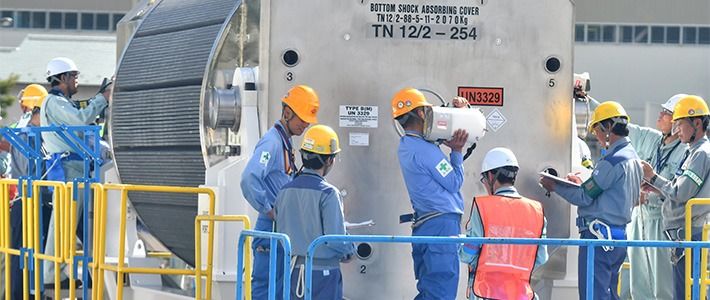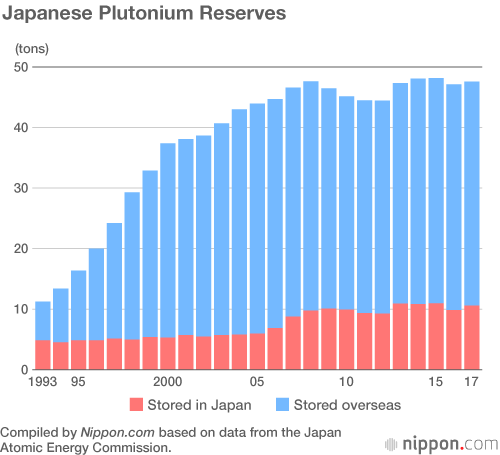
Japan Moves to Reduce Plutonium Reserves Amid International Concern
Science Technology- English
- 日本語
- 简体字
- 繁體字
- Français
- Español
- العربية
- Русский
By year end of 2016, Japanese plutonium reserves were 47 tons in total. Japan held 9.9 tons domestically, and 37.1 tons of the material had been entrusted to Britain and France for reprocessing. The total was roughly 10 tons in 1993, but has gradually increased due to the reprocessing of spent nuclear fuel from nuclear power generation, and has remained high since 2003, when the overall amount cleared 40 tons for the first time.

Since this plutonium can also be used to create nuclear weapons, its strict management is necessary to reduce the risk of nuclear proliferation. The amount held by Japan is the highest among countries that are not nuclear powers, and concerns have been raised by neighboring countries and even by the United States, Japan’s ally.
Plutonium Reserves for Consumer Use Worldwide (Tons)
| Stored domestically | Stored abroad | |
|---|---|---|
| Britain | 133.5 (23.2) | 0 |
| France | 81.7 (16.3) | Less than 0.05 |
| Russia | 57.2 (0.0003) | 0.0006 |
| United States | 49.4 | 0 |
| Japan | 9.9 | 37.1 |
| Germany | 0.50 | Undisclosed |
| Belgium | Less than 0.05 | 0 |
| China | 0.04 | 0 |
| Switzerland | Less than 0.002 | 0 |
Note: Plutonium reserves stored on behalf of other countries are in parentheses.
Compiled by Nippon.com based on document submissions of each country to the IAEA as of the end of 2016.
Japan has established a fuel cycle policy to reprocess nuclear fuel at power plants, extracting and recycling plutonium. According to the Japan Atomic Energy Commission, future plans are, first, to approve reprocessing of plutonium in quantities needed for pluthermal power generation using uranium-plutonium mixed oxide (MOX) fuel in light water reactors; and second, to establish a balance between power demand and supply of plutonium that will reduce the time it takes from processing to utilization by as much as possible, thereby shrinking the reserves. However, the country has yet to set the target values or the timing for these reductions.
The only way to reduce plutonium stocks without discarding them is to increase pluthermal power generation. At present, though, only five nuclear power stations are operating in Japan (a number likely to stay low in the wake of the March 2011 accident at TEPCO’s Fukushima Daiichi Nuclear Power Station), and only four out of the nine reactors online as of August 2018 are capable of pluthermal generation. The Federation of Electric Power Companies has targeted pluthermal installation in 16 to 18 reactors, but the hurdles for implementation are high and there is no forecast for a significant increase. On the other hand, the Japan Nuclear Fuel Limited Rokkasho Reprocessing Plant in Aomori Prefecture is scheduled to be completed in the first half of 2021, and a MOX fuel processing plant is scheduled for completion in the first half of 2022. When fully operational, it will be able to produce 7 tons of plutonium each year.
Under the new policy, it is likely that operations of reprocessing plants will be largely restricted. This will impact the profitability of fuel reprocessing businesses and saddle them with increased burdens in the form of the cost of radioactive waste disposal. There is concern that this will be added to the future costs of power generation.
(Translated from Japanese. Banner photo: Kansai Electric Power Co. (KEPCO) workers measure the radioactivity levels of metal containers containing uranium-plutonium MOX fuel arriving at Takahama Nuclear Power Station in Fukui Prefecture on September 21, 2017. © Jiji.)